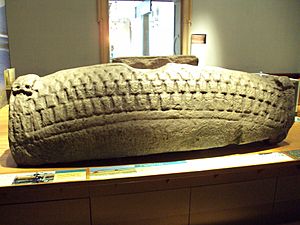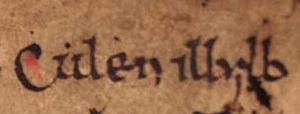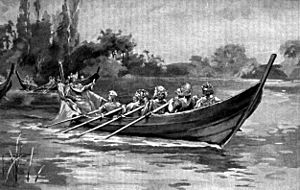Amlaíb, King of Scotland facts for kids
Quick facts for kids Amlaíb mac Illuilb |
|
|---|---|
| King of Scots | |
| Reign | 971/976–977 |
| Predecessor | Cuilén mac Illuilb or Cináed mac Maíl Choluim |
| Successor | Kenneth II |
| Died | 977 |
| House | Alpin |
| Father | Illulb mac Custantín |
Amlaíb mac Illuilb (died 977) was a king of Alba (an early name for Scotland) in the 900s. He was one of three sons of Illulb mac Custantín, King of Alba. His family, the Alpínid dynasty, was very important.
Amlaíb's grandfather had strong connections with the Scandinavian rulers in Dublin. Some people think that Amlaíb and his father, Illulb, had names that came from Old Norse (an old language from Scandinavia). If Amlaíb's name was indeed Scandinavian, it might mean his mother was from a powerful Scandinavian family. She could have been a granddaughter of famous Viking leaders like Amlaíb Cúarán or Amlaíb mac Gofraid.
After Illulb died in 962, the kingship of Alba went to Dub mac Maíl Coluim. He was from a different branch of the same royal family. Dub soon faced challenges from Amlaíb's brother, Cuilén. Cuilén eventually became king himself in 966. Cuilén and another of Amlaíb's brothers were killed in 971. After that, Dub's brother, Cináed mac Maíl Choluim, became king.
Irish records say that Cináed killed Amlaíb in 977. These records call Amlaíb a king, but they don't give Cináed a royal title. This suggests that Amlaíb might have successfully taken the throne from Cináed, even if only for a short time. Amlaíb's brief rule seems to have been between 971/976 and 977.
Who were Amlaíb's Parents and What About His Name?

Amlaíb was one of three sons of Illulb mac Custantín, King of Alba (who died in 962). Amlaíb's grandfather was Custantín mac Áeda, King of Alba (who died in 952). This grandfather had strong links with the powerful Scandinavian rulers in Dublin.
There is evidence that some of Custantín's family members had Scandinavian names. For example, Illulb's name might be a Gaelicised (made more Gaelic) form of an Old English name like Eadwulf. Or, it could be a Gaelicised form of an Old Norse name like Hildulfr.

Another clue about Scandinavian influence comes from Amlaíb's brother, Cuilén (who died in 971). An old book called the Chronicle of the Kings of Alba sometimes calls Cuilén "Culenrīg". The word rīg might mean "ring" or "ring-giver" in Old Norse. This could show a Viking connection. However, it might also be a mistake in the old writing.
Amlaíb's own name is another possible sign of Scandinavian influence. While his name could be a newer version of an old Gaelic name, Amalgaid, it usually comes from the Old Norse name Óláfr. If Amlaíb's name is indeed Scandinavian, it might mean his mother was from a Scandinavian family, perhaps the Uí Ímair. She might have been a descendant of Amlaíb Cúarán or Amlaíb mac Gofraid. By the end of the 900s, people from Gaelic families started having Scandinavian names, and people from Scandinavian families started having Gaelic names. If Amlaíb's name is Scandinavian, he would be one of the first to have such a mixed-culture name.
Family Fights: The Alpínid Dynasty
| A simple family tree of two branches of the Alpínid dynasty: Clann Custantín meic Cináeda (light blue) and Clann Áeda meic Cináeda (light yellow). | |||||||||||||||||||||||||||||||||||||||||||||||||||||||||||||||||||||||||||||||||||||||||||||||||||||||||||||||||||||||||||||||||||||||||||||||||||||||||||||||||||||||||||||||||||||||||||||||||||||||||||||||||||||||||||||||||||||||||||||||||||||||||||||||||||||||||||||||||||||||||||||||||||||||||||||||||||||||||||||||||||||||||||||||||||||||||||||||||||||||||||||||||||||||||||||||||||||||||||||||||||||||||||||||||||||||||||||||||||||||||||||||||||||||||||||||
|---|---|---|---|---|---|---|---|---|---|---|---|---|---|---|---|---|---|---|---|---|---|---|---|---|---|---|---|---|---|---|---|---|---|---|---|---|---|---|---|---|---|---|---|---|---|---|---|---|---|---|---|---|---|---|---|---|---|---|---|---|---|---|---|---|---|---|---|---|---|---|---|---|---|---|---|---|---|---|---|---|---|---|---|---|---|---|---|---|---|---|---|---|---|---|---|---|---|---|---|---|---|---|---|---|---|---|---|---|---|---|---|---|---|---|---|---|---|---|---|---|---|---|---|---|---|---|---|---|---|---|---|---|---|---|---|---|---|---|---|---|---|---|---|---|---|---|---|---|---|---|---|---|---|---|---|---|---|---|---|---|---|---|---|---|---|---|---|---|---|---|---|---|---|---|---|---|---|---|---|---|---|---|---|---|---|---|---|---|---|---|---|---|---|---|---|---|---|---|---|---|---|---|---|---|---|---|---|---|---|---|---|---|---|---|---|---|---|---|---|---|---|---|---|---|---|---|---|---|---|---|---|---|---|---|---|---|---|---|---|---|---|---|---|---|---|---|---|---|---|---|---|---|---|---|---|---|---|---|---|---|---|---|---|---|---|---|---|---|---|---|---|---|---|---|---|---|---|---|---|---|---|---|---|---|---|---|---|---|---|---|---|---|---|---|---|---|---|---|---|---|---|---|---|---|---|---|---|---|---|---|---|---|---|---|---|---|---|---|---|---|---|---|---|---|---|---|---|---|---|---|---|---|---|---|---|---|---|---|---|---|---|---|---|---|---|---|---|---|---|---|---|---|---|---|---|---|---|---|---|---|---|---|---|---|---|---|---|---|---|---|---|---|---|---|---|---|---|---|---|---|---|---|---|---|---|---|---|---|---|---|---|---|---|---|---|---|---|---|---|---|---|---|---|---|---|---|---|---|---|---|---|---|---|---|---|---|---|---|---|---|---|---|---|---|---|---|---|---|---|---|---|---|---|---|---|---|---|---|---|---|---|---|---|---|---|---|---|---|---|---|---|---|---|---|---|---|---|---|---|---|---|---|---|
|
|||||||||||||||||||||||||||||||||||||||||||||||||||||||||||||||||||||||||||||||||||||||||||||||||||||||||||||||||||||||||||||||||||||||||||||||||||||||||||||||||||||||||||||||||||||||||||||||||||||||||||||||||||||||||||||||||||||||||||||||||||||||||||||||||||||||||||||||||||||||||||||||||||||||||||||||||||||||||||||||||||||||||||||||||||||||||||||||||||||||||||||||||||||||||||||||||||||||||||||||||||||||||||||||||||||||||||||||||||||||||||||||||||||||||||||||

Amlaíb and his family were part of the ruling Alpínid dynasty. This was a powerful family that came from Cináed mac Ailpín, King of the Picts (who died in 858). This family was successful because they managed to share the kingship among different family members.
For example, Amlaíb's father's branch of the family took turns ruling with another branch. Amlaíb's father became king after Máel Coluim died and ruled until his own death in 962. When Illulb died, it was the last time Irish and Scottish records mention Viking attacks on the kingdom. The Viking Kingdom of York had fallen by the 950s. The Viking armies from Dublin also seemed to stop their overseas adventures. Unlike English kings, who faced Viking attacks for many years, the kings of Alba had a period of peace from outside threats. However, without outside threats, the Alpínid family started fighting among themselves.

It's not entirely clear what happened after Illulb died. He might have been followed by Máel Coluim's son, Dub (who died in 966/967). Or, it's possible that Dub and Cuilén shared the kingship for a while. They might not have been strong enough to take full control from each other right away.
Even though Illulb's family and Dub's family had been peaceful during Illulb's rule, fights broke out later. Dub seems to have spent much of his time fighting Cuilén. They definitely fought in 965. Dub was removed from the kingship the next year and was killed in 966 or 967. Cuilén's rule seems to have lasted from 966 to 971. His time as king was fairly quiet.
Several sources mention Cuilén's death in 971. The Chronicle of the Kings of Alba says that Cuilén and his brother, Eochaid (who also died in 971), were killed by Britons. It's thought that Cuilén's killer, Rhydderch ap Dyfnwal, was the son of Dyfnwal ab Owain, King of Strathclyde (who died in 975).
Amlaíb's Time as King and His Death

The Chronicle of the Kings of Alba says that Dub's brother, Cináed mac Maíl Choluim (who died in 995), became the next King of Alba. However, Irish records, like old royal family trees and the Annals of Tigernach, suggest that Amlaíb was king before Cináed killed him.
While Cináed might have become king first, it seems Amlaíb was able to take the throne from him, even if only for a short time. The Irish records call Amlaíb a king but only refer to Cináed by his family name. This suggests Amlaíb was seen as the king. It's possible that Amlaíb and Cináed shared the kingship until Amlaíb was killed.

Amlaíb's reign was very short, probably from 971/976 to 977. During this time, the Anglo-Saxon Chronicle mentions that Edgar, King of the English (who died in 975), gathered a large navy and met with six kings at Chester in 975. Two of these kings seem to have been Dyfnwal and Cináed. If Cináed was there, it's unlikely Amlaíb was also present, since only six kings are mentioned.
The exact dates of Cináed's and Amlaíb's reigns are a bit unclear. One of the other kings at the meeting might have been Maccus mac Arailt and his brother Gofraid. These two leaders from the Kingdom of the Isles might have been seen as a threat by the Scots. Maccus and Gofraid had attacked Anglesey earlier, so Edgar's meeting might have been a way to deal with these powerful brothers. After the meeting, the brothers might have focused their attention on Ireland instead of Wales.
Within two years, both Dyfnwal and Edgar died. English records describe the time after Edgar's death as full of "trouble" and "sedition." The chaos from these deaths might have helped Cináed defeat Amlaíb.
An old text from the 1100s says that King Edgar gave Lothian to Cináed in exchange for Cináed accepting Edgar as his overlord. If this is true, it might have happened in the 960s or 970s. This deal could have helped Cináed fight against Amlaíb.
The way the Alpínid family shared the kingship shows that the fights between Cuilén and Dub continued with their brothers. Amlaíb's brother Eochaid died with Cuilén, which shows he was important in the kingdom. The fact that Amlaíb became king after his brother's death also suggests he played a big role in Cuilén's rule.
One of Cináed's first actions as king was to invade the kingdom of the Cumbrians. This might have been revenge for Cuilén's killing. But it's more likely that Cináed did this to show Scottish power, rather than just to get revenge for his family member. In any case, Cináed's invasion failed. This, along with Cuilén's killing, shows that the Kingdom of Strathclyde was a strong power at the time.



